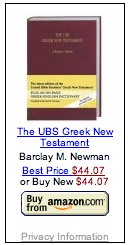Greek Search Comes to Olive Tree iPhone Bible Reader Beta

Above is a screenshot from the beta released last Friday. The actual method for entering Greek text is still a bit awkward, but it’s a good beginning. Hebrew search is not yet implemented, but is in the works.
Olive Tree has given me permission to discuss and post images of the beta.
First Look: Hebrew & Greek Biblical Texts on the iPhone
The screen shots below are from a beta released yesterday from Olive Tree (I have permission to post these images):
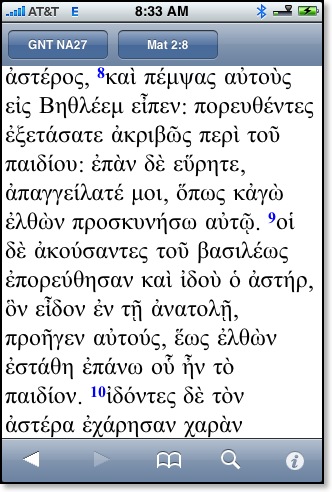

Frequent readers of This Lamp will know that I’ve lamented the loss of original language biblical texts “in my pocket” ever since switching from my Palm Treo to the iPhone last year. After a long wait, Olive Tree comes through with the promise a full replacement, and I have to admit that the texts look much better here than they ever did on my former device.
As you would expect, these texts are fully downloaded to the iPhone and do not require an internet connection for repeated access.
While I’ve got your attention, let me show you a couple of other things Olive Tree is working on for their Bible Reader.
Since my initial review, Olive Tree has incorporated links to textual notes and cross references in their modules.
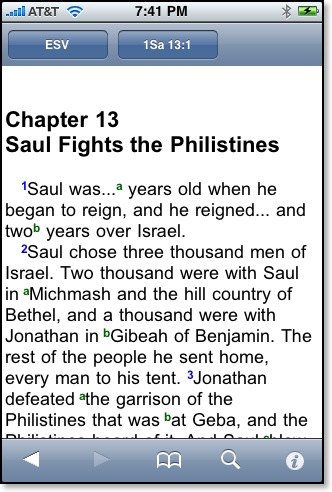

For instance, as demonstrated in the above modules, clicking/touching the superscript letters in the ESV leads to a appropriate section in the ESV notes. This is still not split screen, which I would prefer, but it’s a good start.
Traditionally, Olive Tree has allowed users who purchased texts for one platform to download these on any other platform as well. For instance, after purchasing modules for the Palm years ago, I was also able to download the same texts to a Windows Mobile device while I was testing one out a while back. However, this generous level of cross platform mobility has not been possible so far with the iPhone because Apple tightly controls iPhone apps and requires them to be distributed via the iTunes Store only with the exception of beta releases as seen in some of the images here). And not only do previously purchased modules have to be re-purchased, they have to be purchased separately. Again, this is not a policy from Olive Tree, but rather from Apple.
Right now, for instance, if an iPhone user purchases the NIV Family Pack for Bible Reader and the ESV Study Bundle, two separate installations of the Bible Reader are loaded with each respective set of modules. Other text reader programs in the iTunes App Store have been allowed to include modular purchases, so Olive Tree is trying to work with Apple to make the same kind of access available to users of their Bible Reader.
These screen shots below from a beta release (features not yet approved by Apple) show a “store” from Olive Tree where users could purchase texts directly for download over the internet to their iPhones. Once texts have been purchased and downloaded, they show up on a “My Olive Tree Account” page.
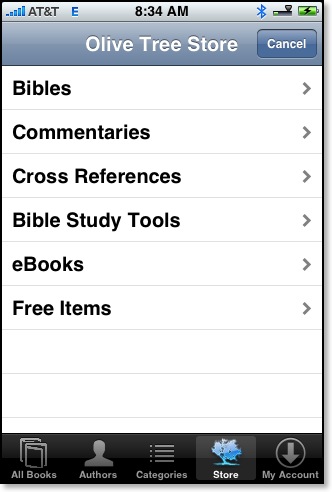


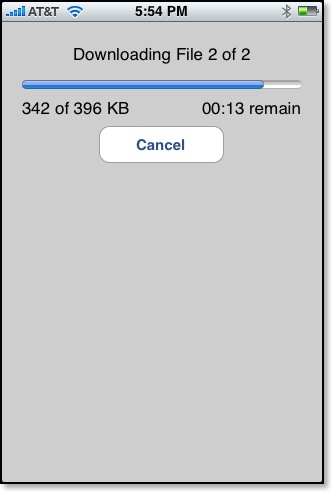

Let’s hope that Apple will approve Olive Tree’s solution because it’s a good and fair answer to the current modular dilemma.
See also:
• Olive Tree’s iPhone page
• To see Olive Tree’s current offerings in iTunes, search for “Olive Tree” in the iTunes Store Search window.
Then in the “Applications” box, select “See All.”
The UBS Greek New Testament: A Readers Edition (A Hands-On, Comparative Review)
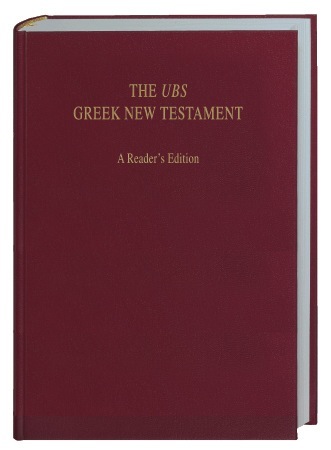
If you haven't read it already, I highly recommend that you see my earlier review of A Reader's Greek New Testament, 2nd Edition from Zondervan for a greater context in understanding this review. If you don't have time to do that, there are four things you should know right up front:
- The UBS Greek New Testament: A Reader's Edition (henceforth UBSRE), is similar in nature to Zondervan's A Reader's Greek New Testament (RGNT from this point forward) which has been published in two separate editions. The first was based upon the Greek text underlying the NIV, and the second is based upon the Greek text underlying the TNIV. All three of these New Testaments include a Greek text with a vocabulary apparatus at the bottom of the page containing definitions for all words that occur less than 30 times in the New Testament. The purpose of such an edition is to allow the reader with at minimum a basic foundation of Greek study to simply read the New Testament in Greek without having to constantly consult a lexicon for words not in one's working knowledge.
- As I explained in the previous review of the RGNT2, although I originally bought the Zondervan RGNT1 for the novelty of having the underlying NIV text, I actually found the volume quite useful, especially as a tool to throw into my book bag that I carry to church on Sundays. I found the idea of a Reader's New Testament in Greek with the vocabulary apparatus is extremely handy when I simply needed to consult the text and wasn't worried about text critical issue or didn't have the time to look up complete definitions in my BDAG lexicon.
- I was never fond of the italic text in the RGNT1, but it was bearable. I was extremely disappointed in the release of the RGNT2 in that although the text was changed to a non-italic font, it used a style with thinner character strokes that actually made the text more difficult to read in my opinion.
- Finally, about a year or so ago, a professor at a seminary extension contacted me wanting to know if I had heard whether the RGNT was being discontinued due to threat of a lawsuit from the United Bible Societies or the German Bible Society. I could not confirm any such lawsuit at the time or that the RGNT was being taken off the market (it was not). However, I did confirm from an off-the-record source recently that there was talk of an actual lawsuit, but it was deemed that since the standard eclectic Greek New Testament is based upon public domain ancient manuscripts, such a suit would not be able to stand up in court.
I'm happy to report that nothing ever came of the lawsuit talk. I would have greatly disappointed (especially in light of 1 Cor 6:1ff) if one Bible publisher had decided to sue another Bible publisher. Rather, the German Bible Society decided to create their own edition of a Greek New Testament similar to Zondervan's RGNT. The UBS version, however, is based upon the UBS Greek New Testament, fourth revised edition. The main features of the UBSRE include the following:
- Translation of all vocabulary items occurring 30 times or less in the New Testament at the bottom of the page
- Translations given according to context
- Definitions of idiomatic word combinations
- Grammatical analysis of all difficult verb forms
- Reader-friendly layout enabling the reader to transfer easily from text to dictionary and vice versa
- An appendix providing translations of all vocabulary items occurring more than 30 times in the New Testament
- The maps from the USB Greek New Testament.
I find it impossible to review the UBSRE without reference to Zondervan's RGNT, so I would prefer to offer a comparative review. From the outset, the immediate difference between these two is size. Although, both have about the same dimensions in height and width (both volumes are around 6" x 9"), the UBSRE is essentially twice as thick as the RGNT. Zondervan's product page for the RGNT states that it contains 576 pages, while the German Bible Society's product pages lists the UBSRE at 712 pages. So why is the UBSRE twice is thick as the competing product, even though it is less than 200 pages longer? Well, it has to do with the very thin paper and space-conserving format used in the RGNT, but I'll write more about that in a moment.

Admittedly, I like the soft, leather-like Italian DuoTone cover on the RGNT better than the hardcover binding of the UBSRE. The Zondervan product feels like a Bible, while the UBS edition feels like a book. The UBSRE is bound in what has become the signature burgundy cover with gold lettering that is used with most editions of the UBS Greek New Testament. However, I know that they also produce flexible covers, and I believe one would be appropriate for this edition.
Nevertheless, it's what's inside that counts, and this is where the UBS shines. I'll get to the layout issues in a moment, but first a few comments on the vocabulary apparatus. The apparatus itself is referred to in the introduction and on promotional materials as a "Running Greek-English Dictionary." The RGNT has this, too, of course, but the UBS edition may just be better. The definitions have been adapted from Barclay Newman's Concise Greek-English Dictionary of the New Testament contained in many UBS editions of the Greek New Testament. Of course, because of space, the definitions have been shortened based upon the context. Therefore, the the contextual decision may theoretically imply some amount of interpretation upon the editor's part, but this would not be any different from using Trenchard's glosses in the RGNT. Further, the running dictionary is not meant to replace use of a lexicon, but merely to allow quick access to the meaning of the text in certain contexts.
The UBSRE also breaks with the Zondervan editions in that it offers grammatical help on what the editors consider more difficult forms. So for instance, in John 1:42, both the UBSRE and the RGNT offer a definition for ἐμβλέψας. The RGNT: "ἐμβλέπω, I look at, consider." The UBSRE: "ἐμβλέπω aor act ptc m.s.nom, look straight at." For many readers, this extra grammatical information is going to be very helpful.
Like the RGNT2, the UBSRE also offers a mini glossary of Greek vocabulary words occuring more than 30 times (the ones that don't get listed with the text) in case the reader simply forgets what shoudl be a memorized word. But this is also a place where the two editions differ greatly. The word list in the RGNT2 is based on Warren C. Trenchard's Complete Vocabulary Guide to the Greek New Testament, so it's definitions are fairly short as one would expect. So, for instance, if one were to look up ἀγαθός in the RGNT2 appendix, would would find this entry: "ἀγαθός, ή, όν (102) good" (the numeral indicates how many times the word occurs in the Greek NT). However, because the definition appendix in the UBSRE bases its entries on Barclay Newman's dictionary, one will find a much more detailed entry: "ἀγαθός, ή, όν good; useful, satisfactory for one’s (its) purpose, fitting, beneficial; sound (of trees), fertile (of soil), happy (of days); in a moral sense upright, just; kind, generous; clear (of conscience); perfect, inherently good (of God); τὸ ἀγαθόν the good, what is good; what is right or upright; what is beneficial or advantageous; τὰ ἀγαθά goods, possessions; good things (Lk 16:25); good deeds (Jn 5:29)." That's quite a difference, but to be fair, one could argue that the RGNT2 offers the most essential information with the understanding that more detail can be derived from other resources. But again, for some readers, this extra information will be seen as quite helpful. I should also point out that the glossary in the RGNT only fills a little less than six pages, while the corresponding feature in the UBSRE fills 22 pages.
This leads me to what I believe is the most significant difference between the UBSRE and the RGNT2: layout and readability. The UBSRE is simply easier to read than the RGNT2. It's font is larger and the text is laid out leaving more white space on the page. Further, the running vocabulary list in the UBSRE runs in a two-column list which allows one to easily find the word he or she is looking for.
I took my own scans of each edition for this review rather than relying on the PDFs made available from each publisher. I thought this might give a fairer comparison between each edition. If the lines don't seem quite straight, it's from a less than perfect attempt on my part to hold the volume flat on my scanner.
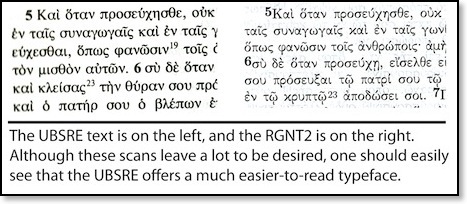
As I stated in the review of the RGNT2, part of the problem comes from my perception that Zondervan, normally a maker of quite excellent reference works, has an unhealthy preoccupation with thinline Bibles. Since the RGNT is a New Testament, someone in marketing or layout and design must have suggested than a thinline form factor be adopted. I'll be the first to admit, that the RGNT fits much more nicely in the hand than the UBSRE. However, this is strictly form over function. The UBSRE doesn't suffer from small print, cramped text, or near as much bleed through (which is even evident in the above samples) as the RGNT2. This issue is also apparent when you look at a full page spread of each edition.
[Note that neither of the scans below captured the full margins of either edition since my scanner space was smaller than a full page spread of either edition.]
First, the RGNT2 (click on the image to get a larger, more detailed view).
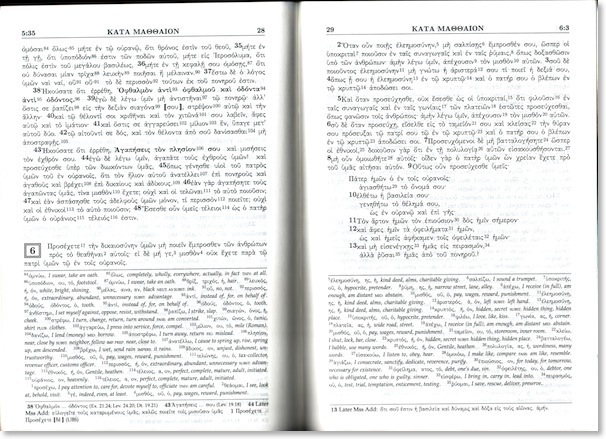
And now, the UBSRE (again, click on the image to see a larger, more detailed view):
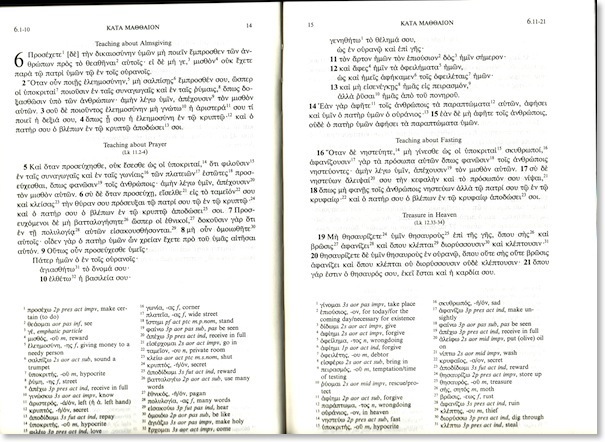
In my opinion, the UBSRE is much more inviting. Section headings separate pericopes, and parallel passages in other gospels are also noted. Of course some people prefer a straight text without section headings. If this is the case, the RGNT may be preferred to those readers. Finally, finding the definition of a word in the UBSRE is made much simpler and quicker with the two columns, rather than hunting through the paragraphed text of the RGNT's apparatus.
WHAT'S MISSING?
Not much. There's very little in the RGNT2 that's missing in the UBSRE. However, I felt the Scripture references for OT quotations in the RGNT2 were a very welcome addition, and one that the reader will not find in the UBSRE. The maps are a bit nicer in the RGNT2 than the standard UBS maps. The RGNT2 also added a few, sparse textual notes in addition those that referenced divergences from the UBS text. The reader of the UBSRE will still need to consult a more traditional edition to see textual issues.
Something should also be said about price. The UBSRE is significantly more expensive than the RGNT. I've stated for a long time that UBS prices were out of control, and this edition is no different. Even with discounts at places like Amazon or CBD, one can expect to pay about $20 more for the UBSRE over the price of the RGNT.
FINAL EVALUATION
Although initially, I was very excited about the release of the RGNT2 and its promised improvements over the first edition, I was quite disappointed in the final product. Yes, the thinline aspect of the RGNT2 might initially seem like a bonus over the twice-as-thick UBSRE, but in actual use, function simply wins out over form for me. The UBSRE is a better product because the designers of it did not choose to take shortcuts necessary to create a thinner form factor. From what I've heard, the RGNT had been greatly cutting into the sales of UBS/NA Greek New Testaments over the past few years, and the UBSRE is nothing less than a counter strike, and a significant one at that.
One last thing. If you read my review of the RGNT2, you'll remember I lamented that a ribbon marker was missing, in spite of the fact that one had been promised in early promotions, and even listed as a new feature on early shots of the box cover. Well, potential purchasers of the UBSRE will be glad to know that it does, in fact, come with a ribbon marker. Admittedly a minor detail, but handy for any reader, nonetheless.
A. T. Robertson on The Minister & His Greek New Testament

It ought to be taken for granted that the preacher has his Greek Testament. This statement will be challenged by many who excuse themselves from making any effort to know the Greek New Testament. I do not say that every preacher should become an expert in his knowledge of the New Testament Greek. That cannot be expected. I do not affirm that no preacher should be allowed to preach who does not possess some knowledge of the original New Testament. I am opposed to such a restriction. But a little is a big per cent. on nothing, as John A. Broadus used to say. This is preeminently true of the Greek New Testament.
The real New Testament is the Greek New Testament. The English is simply a translation of the New Testament, not the actual New Testament. It is good that the New Testament has been translated into so many languages. The fact that it was written in the koiné the universal language of the time, rather than in one of the earlier Greek dialects, makes it easier to render into modem tongues. But there is much that cannot be translated. It is not possible to reproduce the delicate turns of thought, the nuances of language, in translation. The freshness of the strawberry cannot be preserved in any extract.
The preacher cannot excuse himself for his neglect of Greek with the plea that the English is plain enough to teach one the way of life. That is true, and we are grateful that it is so. The Bible is in the vernacular and has entered into the very life of the modem man. It is impossible to overestimate the influence of the King James Version upon the language and life of the English-speaking world. ... But words are living things and, like all life, are constantly changing. Dictionaries run out of date quickly, not merely because of new ideas and new words, but because the old words change their meanings.
We excuse other men for not having a technical knowledge of the Bible. We do not expect all men to know the details of medicine, law, banking, railroading. But the preacher cannot be excused from an accurate apprehension of the New Testament. This is the book that he undertakes to expound. It is his specialty, and this he must know whatever else he does or does not know. Excuses for neglecting the New Testament are only excuses after all.
Now, the Greek New Testament has a message for each mind. Some of the truth in it has never yet been seen by anyone else. It is waiting like a virgin forest to be explored. It is fresh for every mind that explores it, for those who have passed this way before have left it all here. It still has on it the dew of the morning and is ready to refresh the newcomer. Sermons lie hidden in Greek roots, in prepositions, in tenses, in the article, in particles, in cases. One can sympathize with the delight of Erasmus as he expressed it in the Preface of his Greek Testament four hundred years ago: "These holy pages will summon up the living image of His mind. They will give you Christ Himself, talking, healing, dying, rising, the whole Christ in a word; they will give Him to you in an intimacy so close that He would be less visible to you if He stood before your eyes."
Many who saw Jesus in the flesh did not understand Him. It is possible for us all to know the mind of Christ in the Greek New Testament in all the fresh glory of the Galilean Gospel of grace. The originality that one will thus have is the joy of reality, the sense of direct contact, of personal insight, of surprise and wonder as one stumbles unexpectedly upon the richest pearls of truth kept for him through all the ages.
The trouble with all translations is that one's mind does not pause long enough over a passage to get the full benefit of the truth contained in it. The Greek compels one to pause over each word long enough for it to fertilize the mind with its rich and fructifying energy. The very words of the English become so familiar that they slip through the mind too easily. One needs to know his English Bible just that way, much of it by heart, so that it will come readily to hand for comfort and for service. But the minute study called for by the Greek opens up unexpected treasures that surprise and delight the soul.
Three of the most gifted ministers of my acquaintance make it a rule to read the Greek Testament through once a year. One of them has done it for forty years and is as fresh as a May morning to-day in his preaching. One of them is a man of marked individuality and he has added to undoubted genius the sparkling exuberance from the constant contact of his own mind with the Greek text. There is thus a flavor to his preaching and speaking that makes him a marked man wherever he appears upon the platform. He makes no parade of his learning, but simply uses the rich store that he has accumulated through the years. He brings out of his treasure things new and things old. And even the old is put in a new way. Light is turned on from a new angle of vision. The old has all the charm of the old and the glory of the new.
There is less excuse than ever for the man with college and seminary training who does not turn his knowledge of Greek to tremendous account. His tools are far superior to those of a former generation.
The most perfect vehicle of human speech thus far devised by man is the Greek. English comes next, but Greek outranks it. The chief treasure in the Greek language is the New Testament. Homer and Thucydides and Aeschylus and Plato all take a rank below Paul and John and Luke. The cultural and spiritual worth of the Greek New Testament is beyond all computation. In the Renaissance the world woke up with the Greek Testament in its hands. It still stands before the open pages of this greatest of all books in wonder and in rapture as the pages continue to reveal God in the face of Jesus Christ.
A Reader's Greek New Testament, 2nd Edition: Hands On Review
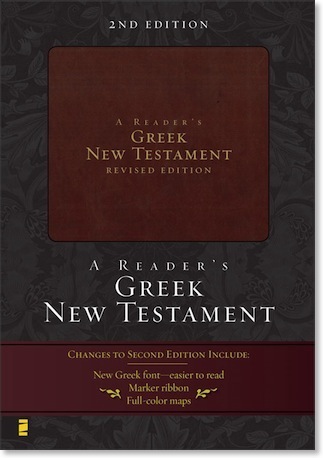
What No One Wants to Talk About
There's a dirty little secret among ministers throughout Christendom: most of them have let their biblical languages slide after graduating seminary. It's sadly understandable, I suppose. Learning a language is hard enough, but maintaining that language takes time and discipline. It's not that ministers are undisciplined (well, maybe some are), but when they get out of school and into the "real world" of ministry, they find new obligations and demands upon their time. Reading the Bible in Greek or Hebrew is replaced with an occasional word study to get at the "meaning" behind key biblical words.
That's where a book like A Reader's Greek New Testament (from this point forward, simply RGNT for the general work and RGNT1 and RGNT2 for the respective editions) can help fill the gap. I'm told there are 5,347 distinct words in the Greek New Testament. The average student taking elementary Greek will only learn a little over 300 vocabulary words in that first course. This accounts for roughly all words that occur in the Greek NT 50 times or more, or approximately 80% or so of words occurring in the NT. A second course related to syntax and exegesis will increase the number of learned vocabulary falling somewhere between 30 and 10 occurrences. The key feature of A Reader's Greek New Testament is the vocabulary apparatus at the bottom of the biblical text which gives definitions for all Greek words occurring 30 times or fewer.
This is a handier tool than one might at first realize. You see, there's another dirty little secret, and this one is among even the most trained academics and theologians: very few scholars ever memorize all 5,347 words. I've sat under quite a few professors in my time, some of whom are quite well known in the world of biblical studies. However, I could probably count on one hand the number of individuals I've known who could "cold read" any passage in the NT and do so well. I admit that years ago I tested this out on more than one occasion on more than one professor. I began to pick up on the fact that when we had a focal passage for study for a day, a professor could read from the Greek quite smoothly. But as soon as a question was asked about another passage, stumbling and stuttering began as an attempt was made to read the unplanned text. Again, I can count on one hand the individuals I've known who seemed to be able to smoothly read aloud any passage from the NT without advanced preparation.
I won't be a hypocrite. I admit up front that I don't have all 5,347 words memorized either. It's a worthy goal, but I haven't reached it, and frankly at the moment I'm not even attempting to. At some point way back, I worked my way through one of those boxes of 1,000 Greek vocabulary cards. Those boxes will get the Greek student down to about all words that occur 10 times or more. I use my Greek almost daily, but I haven't reviewed all 1,000 vocabulary cards in a long time. If I had to guess, I would assume that as of this moment, my current mastery of Greek words falls somewhere below that 30x mark and above that 10x mark.
The Value of the RGNT
I picked up the first edition of the RGNT based mostly on the sheer novelty of the fact that it represented a different Greek text than the "Standard Edition"; that is, the Greek text underlying the NIV Bible (more about that in a moment). But the more I used it, the more I saw the value of what it was designed for: the RGNT allowed me to read the NT in Greek without having to constantly look up words that I didn't know the definition of off the top of my head. They were simply defined at the bottom of the page. Of course, there's value in consulting the lexicons for more in-depth treatment, but I would suggest that very few non-specialists who learn Greek (or at least take Greek classes) ever really read Greek. Instead, they simply muddle their way through. I've been there myself, and it's taken quite a bit of study to proceed further. But the RGNT will help anyone with a basic foundation in Greek studies actually read the NT in its original language.
Although for years I'd carried with me one of those "standard" Greek texts (first the UBS 3rd edition, and later the 27th edition of the Nestle-Aland text), I found myself picking up the RGNT more and more after I bought it. I especially grabbed it for non-academic purposes such as church use. I found that when teaching a Bible study, if I was asked a question that required consulting the Greek text (which happens now and then), I was able to stumble around less on those cold readings if I had the RGNT. So I would imagine that over the last couple of years, when carrying a Greek NT with me, the RGNT has been my choice at least 50% of the time.
The value of the RGNT is fairly universal. Certainly, it's a great tool for the person in ministry, who's out of school, but wants to continue using his or her Greek skills. It allows a pastor to realistically work in actual Greek for exegesis when preparing a sermon because less time is involved. For the student who has recently begun studying Greek, it's a great way to stay in the Greek text and rely less on outside aids. Of course, I've warned folks that the average professor is probably not going to allow it for an exam. But even beyond new students and graduated students, the RGNT is an immensely practical resource for looking to the original languages first as opposed to a translation. Some might be tempted to call it a crutch, but I would contend that the more a person used the vocabulary apparatus at the bottom of the page, the less it would be used over time as new vocabulary was mastered.
The Underlying Text
It's very important that anyone considering the use or purchase of the RGNT know that text itself varies slightly from the accepted, so-called "Standard" eclectic Greek text. For those unfamiliar with this, the average Greek NT bought off the shelf today, whether a UBS 4th edition or a Nestle-Aland 27th edition, does not represent a single Greek manuscript, but is rather an amalgam of what is considered the best and most reliable readings from the manuscript evidence. But sometimes opposing variant readings have such strong evidence that scholars disagree over which variant represents the original. There are formal, but not always rigid rules for making such decisions and this process is known as textual criticism. Bible translators use these standard texts when creating or revising a translation of the Bible, but I suppose the third dirty little secret today is that every translation on the shelf contains some renderings in which the translation committee disagreed with the decision of those who put together the standard text. But until the first edition of the RGNT, it was difficult determining with any translation how many times a committee went rogue against the decisions in the standard text.
The first edition of the RGNT was released in 2003 containing a reverse-engineered Greek text reflecting the translation decisions found in the NIV Bible. So how many times did the NIV translators opt to go with variant readings? Evidently, the magic number is 231. Is that good, bad, on par with other translations? Who knows? This had never been done before (to my knowledge). The newly released second edition also features an underlying Greek text, but not for the NIV. Rather, the underlying Greek text of the RGNT2 is based upon its successor, the TNIV. Regular readers of This Lamp will correctly assume that I'm very pleased with this decision. I've been concerned in the past that Zondervan was still holding on too tightly to the NIV rather than giving deference to the newer and more accurate TNIV. Not only is this change of translations between editions forward-thinking, the RGNT2 represents one of the first reference work related to the original Greek associated with the TNIV, further legitimizing academic use of this translation.
But wait--there's more. One might expect the number of deviations in the Greek text underlying the TNIV to remain close in number to those in the NIV. Not so. Would you believe that the number of deviations from the standard text in the TNIV is 285? That means there is well over 50 separate instances in which the TNIV Committee on Bible Translation made decisions for readings that differed from their predecessors who worked on the NIV. Are these decisions good ones? Well, that will have to be examined, but at least now with RGNT2, we know where they are.
Further, this will settle some questions about the differences between the TNIV and NIV once and for all. For instance, a while back I wrote about the difference between the two translations in their rendering of Mark 1:41 (see here and here).
|
Mark 1:41
|
|
|
NIV
|
TNIV
|
| Filled with compassion, Jesus reached out his hand and touched the man. “I am willing,” he said. “Be clean!” | Jesus was indignant. He reached out his hand and touched the man. “I am willing,” he said. “Be clean!” |
At the time, I wrote to the International Bible Society hoping that my question about the extremely different rendering would be passed on to the TNIV CBT. However, and IBS intermediary answered the email himself and went to great length to defend a decision to translate σπλαγχνίζομαι/splagchnizomai (the underlying Greek word translated in the NIV as "filled with compassion") as indignant in the TNIV. It didn't make much sense to me then, and as I looked at the issue a bit more, I discovered that there was another variant to Mark 1:41 that included the word ὀργίζω/orgizō (be angry, be furious) instead of σπλαγχνίζομαι/splagchnizomai. Upon receiving the RGNT2 in the mail this week, one of the first things I looked up was Mark 1:41 and I was not all too surprised to see that the TNIV does in fact use the variant that contains ὀργίζω/orgizō. Originally, upon receiving the RGNT2, my plan was to sell the first edition. However, I now believe it would be valuable to hold on to both for just these kinds of comparisons.
Improvements in the 2nd Edition
In addition to updating the textual basis, a number of other improvements have been made in the RGNT2. I've complained before that I didn't care for the italic Greek font in the RGNT1. Most will be pleased to know that the text has been completely reset in a non-italic font. Unfortunately, I'm still not satisfied with the new font, but I'll speak more to that below.
The RGNT is known for including vocabulary words at that bottom of the page for all words that occur 30 times or fewer. But what if the reader forgets the definition of one of those words that occur more than 30 times? I'll never forget the time I was in a class about a decade ago and it was my turn to recite a text and I completely blanked on a very basic, frequently occurring word (ποιέω/poieo). Well the new RGNT2 includes a "mini-Lexicon" (it's actually called that) in the back that includes all those words occurring 30 times or more. It's a good way to review vocabulary as well. All definitions, like those in the apparatus with the text are taken from Warren Trenchard's Complete Vocabulary Guide to the New Testament. The mini-lexicon takes up only 6 pages, much fewer than I would have imagined.
Four color maps relating to the New Testament have been added. These maps will be recognizable to anyone who's bought a Zondervan Bible in recent years, but they are certainly a welcome addition. Old Testament quotations within the NT text are now referenced in a separate apparatus at the bottom of the page. This second apparatus also includes notations to differences in the standard NA/UBS Greek text as well as a few minimal textual notes such as "Later MSS Add... ." Again, no one is going to be able to do hardcore textual criticism with this New Testament, but the improvements in the RGNT2 help to make it a more complete package for most situations.
Like the previous edition, the new RGNT2 comes in an "Italian Duo-Tone" cover, which is a very leather-like imitation leather. Personally, I like the cover just like I did in the first edition. It feels immediately soft like a leather that has experienced a good amount of use already. I'm not sure any of us know what these new kinds of imitation leathers will look like in 20 years, but I'm not concerned. And I especially appreciate the lower cost (about $23 on Amazon.com).
What I found very interesting, though, is that contrary to early advertisements promoting a marker ribbon, no such item is included. In fact, as of this writing. the box cover image on both Amazon.com AND the Zondervan website (reflected at the top of this post) promises a marker ribbon. Evidently, the ribbon was cut at the last minute, but still done in time to update the box cover which now sports only two "Changes to Second Edition" in the copy on the front of the box (the new supposedly easier to read Greek font and the full-color maps).
I might also point out, too, that when I did my earlier "first look" (i.e not hands on) review of the RGNT2, I speculated based on released PDF files that this new edition might have wide margins. Sadly, it does not.
A Reader's Edition That's Difficult to Read
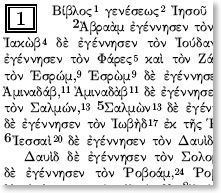
One of the supposed improvements in the second edition over the first edition of the RGNT is the new non-italic typeface (seen in actual size to the right). It's true, I've never liked italic Greek typefaces or saw the need for them. My first Greek New Testament years ago was a USB 3rd edition that had an italic, but readable typeface. However, I thought the 4th edition italic font was horrible and I've never used it. I have generally preferred instead to use a Nestle-Aland 27th edition Greek New Testament with non-italic type. I was never fond of the italic type in the RGNT1, but the work itself was so very practical that as described above, I've used it regularly over the last two or three years.
I was excited about the prospect of non-italic type in the RGNT2. Yet, when I saw the type of the main body text, I was astounded. I believe I said aloud, "My goodness, it's actually worse." The strokes that form the characters in this Greek font are so very thin that in my opinion, the second edition is even more difficult to read than the first. If you think about it, this completely contradicts the concept of a supposed "Reader's Edition" because what Zondervan has produced is a work that is difficult to read! I can only imagine that extended time spent with the RGNT2 would seriously make one's eyes ache.
And to illustrate the oddity of this thin Greek font, all I have to do is point to the English font in the introduction of the work. It looks like it is probably about a 10 point Times-based font. It's easy to read. But it's in stark contrast to the thin letters in the Greek text. And to add even further evidence to the impracticality of this font, I should point out that the compilers of the RGNT2 chose an entirely different and thicker (i.e. normal) font for the Greek in the mini-lexicon. If they had used the same Greek typeface in the main text that they had used in the lexicon, I would have no complaint.
I showed the new edition to one of my Greek students with the original edition for comparison. I waited for a reaction. He looked back and forth at the two editions and then he asked, "Wait a minute...is the new typeface smaller?" I'm not so sure it's smaller, but it's definitely thinner. In fact because of the new typeface that takes up less space, the second edition comes in at 11 pages shorter than the first edition--and that's including the mini-lexicon in the second edition!
I can only speculate that the desire to have so few pages comes from what I see as a preoccupation that Zondervan has with thinline Bibles. Personally I can't stand thinline Bibles because compromises have to be made to reach a smaller size and that usually means small, cramped type and pages that are way too thin. And, of course, think paper leads to text bleed-through from underlying pages. All three are true for the RGNT2, and all three make this edition even more difficult to use than the first.
I complained to Zondervan about the thinline format because of the sacrifices in the type and paper, but Zondervan's marketing shows that people really seem to prefer thinline Bibles. I'm sure they do. They are compact and easy to carry, but personally, I don't find them practical for regular/heavy use. If I were to make a publishing rule regarding such things, I'd say never produce thinline reference works.
Further, in regard to my complains about the type, I was told that at the recent SBL & ETS conferences, attendees were given the chance to compare the two editions:
"I can say this that the vast majority of those at the convention who looked at the two editions preferred the second edition's font over the first as being much easier to read. Even though the first edition was $5.00 cheaper than the second edition and we had lots of both editions at the conventions, we sold out of the second edition first at both conventions, and 'from my perch' I made sure that people looked at both fonts if they were unaware of the first edition."
My hunch is that people looking at the two simply prefer the non-italic type in the second edition over the italic type in the first, but time will tell. It's a different issue altogether when one is actually trying to use a work like this as opposed to simply looking at it in a conference booth.
I'm going to really attempt to use the second edition despite my initial misgivings. I didn't like the italic type of the original edition at first, but it grew on me. However, I don't know if that will be possible with a font that's simply difficult to read.
No Longer the Only Game in Town
About a year or so ago, I had a professor from a seminary extension contact me about the original RGNT. He was using it in his Greek classes, but he had heard that the United Bible Societies were going to sue Zondervan over their Reader's Edition in spite of the 231 places where it diverged from their text. He was so concerned about this, he had been buying up extra copies of the RGNT for his future students to buy from him. He wanted to know if I had heard about any of this. I had not heard about it, but I didn't believe at the time that any such lawsuit was be tenable in a court of law because the UBS text is made up of an arrangement of public domain ancient manuscripts. Later on I would find out that such an idea for a lawsuit had indeed been considered, but eventually abandoned because of the exact reason I suspected.
Nevertheless, there is a new UBS Greek New Testament: A Reader's Edition to compete with Zondervan's. Granted, it's $20 more expensive than Zondervan's (UBS prices are out of control in my opinion) even at discounters, but it may end up giving Zondervan's RGNT2 a run for it's money. I have not held one in my hand yet (when I do, I'll offer yet another review), but based on PDF's, I wonder if they haven't built a better mousetrap. My concerns about the typeface in Zondervan's RGNT don't look like they will be an issue in the UBS edition based on what I've seen. I would invite you to compare the PDF sample for the UBS Reader's Edition to the PDF sample for the Zondervan RGNT2 and let me know your thoughts. I should also point out that the UBS text is about 200 pages longer than the Zondervan version and it is definitely not a thinline.
Concluding Thoughts
Zondervan has developed a wonderful concept with its Reader's Greek New Testament which is aimed at allowing a person with at minimum basic Greek skills to simply read the New Testament in its original language without having to consult a full lexicon every few words. Most of the additions to the second edition are welcome and for the most part improves upon its predecessor. I especially like having the text that underlies the TNIV. Since I teach out of the TNIV at church, the RGNT2 would seemingly make for an excellent complementary resource. Unfortunately, the ghastly thin typeface in the second edition threatens to defeat the purpose of this being a reader's edition because it's simply difficult to read. If the new UBS Reader's Edition begins to cut into Zondervan's sales, I hope they will consider resetting the type as quickly as possible. Unfortunately such projects never take place quickly, and I wouldn't expect anything different from the current RGNT2 for at least three years or more.
First Look: A Reader's Greek New Testament, Second/Revised Edition
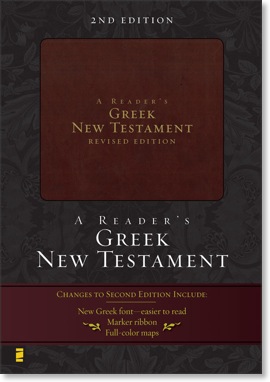
SOME BACKGROUND: THE FIRST EDITION
I've always found A Reader's Greek New Testament (RGNT from this point forward) to be an extremely practical resource. The RGNT addresses the issue that while there are over 5,000 distinct words in the Greek NT, the reality is that many of this words only occur a few times or even in single occurances. While it's an admirable goal for a student of Greek to memorize every word, it's not a reality for most. Most introductory grammars, in fact, only cover a little over 300 words, but these words occur so frequently that they account for roughly 80 of the entire New Testament. But that remaining 20% is still enough from keeping the average person who has a familiarity with Greek from sitting down and reading the New Testament in its original language as easily as one might read an English translation. In fact, in my experience and observation, I've known personally of only about two or three people who can really read the Greek NT without stumbling. Oh, sure, the dirty little secret is that any of us can read a passage just fine when we've taken the time to work through it ahead of time. But as soon as someone asks us a question about a different passage--one that we haven't prepared beforehand, we stumble and stammer as we try to read it in a quick and efficient manner.
The RGNT is noted for including lexical forms for all words of the Greek New Testament that occur 30 times or less. If this sounds like a crutch, think again. The reader still has to know his or her Greek grammar fairly well to use this resource. In fact, I tend to carry the first edition of the RGNT with me to church on Sundays. If I need to look up something quickly, and come across a word that's not part of my working vocabulary, I can look at the footnote at the bottom of the page. It's not realistic for me to carry a lexicon with me to church, and I usually don't have my MacBook so that I can access such tools in Accordance. Perhaps one day, I'll make time to memorize all 5000+ words in the Greek NT, but for right now it's not a practical goal and the RGNT is an ideal solution.
The other distinct feature of the RGNT first edition has to do with its textual basis. Most might assume that this is simply an edition of the current UBS/NA eclectic Greek text with a special apparatus. Not so. The Greek text in this edition is actually one that has been retrofitted, so to speak, to match the text that underpins the New International Version. The reality is that every translation committee makes decisions that sometimes causes them to choose a different textual route than the majority opinion of the UBS/NA committees. The RGNT first edition has about 200 instances, all noted in the footnotes, where its text differs from the standard text.
IMPROVEMENTS/CHANGES IN THE SECOND EDITION
New Greek font. I don't know if the font itself is actually a different font, but the main difference from the first edition is that the text in the second edition is not in italics. And I say, "Thank goodness!" My major complaint about the first edition of the RGNT is the italicized text that is extremely difficult to read. I have no idea why some publishers of Greek texts like to do this. The UBS 4th edition Greek NT uses a horribly thin italicized text also making it difficult to read. Thankfully, Zondervan changed this policy in the RGNT 2nd edition.
However, the font itself does look slightly smaller than the original edition. I've made a comparison in the graphic below that displays the first page of Matthew's Gospel on the left in the first edition and with the second edition on the right (note that the image below is not actual size).
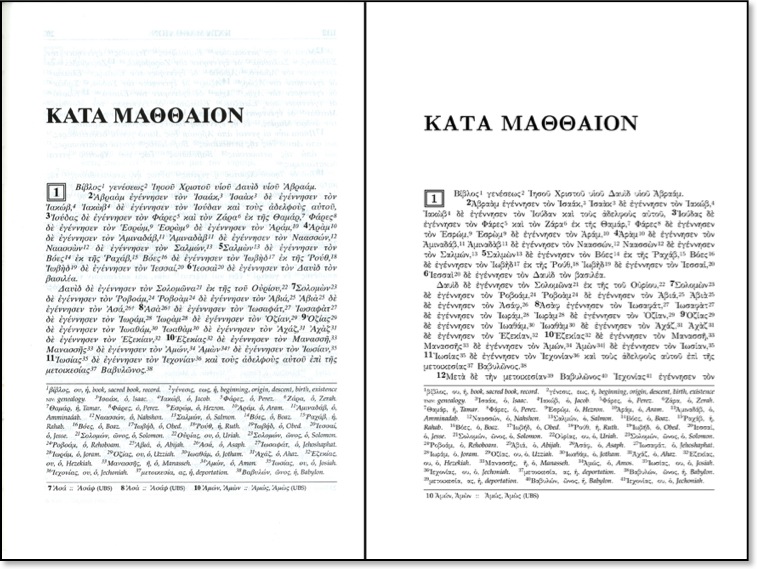
The observant reader may notice that there's slightly more text (most of Matt 1:12) on the second edition page. Therefore, the font is either tighter or smaller. Zondervan offers a PDF sample of the RGNT2 featuring the first five pages of Matthew. The second edition ends with Matt 3:17 while the equivalent page in the fist edition ends with 3:15. Two verses--is that a big deal? Probably not, but there is definitely an attempt to use fewer pages. Why? Because while there are more features in the RGNT2, but there are actually fewer pages than the first edition. Therefore, an attempt was made to conserve space. And while I wish Zondervan had not chosen to use a tighter/smaller font, I will say that regardless, the new text is much easier to read than the italicized text of the first edition.
But that brings us to another issue, and frequent readers of This Lamp will have to pardon a familiar complaint that I've discussed many times before. This New Testament, (presumably) like its predecessor is a thinline. How do I know this? Well, in spite of the fact that complete measurements have not been released, we do know a few things. I'm guessing the dimensions are a bit wider because the outer margin on each page is wider (see more below). We also know that although there is about a twenty page difference in the two editions, the weight is comparable (1.065 lbs. for the first edition vs. 1 lb. for the second edition). Thickness measurements for the second edition have not been released, but the first edition is 7/10 of an inch thick. Since the two editions weigh virtually the same, I can only assume that the second edition will be just as thin.

Personally, I hope that one day, publishers will get over their infatuation with thin Bibles and realize that the target market for a resource like this does not mind having a book that is somewhere between one inch and one and a half inches in thickness. I'm sorry, but cramming 576 pages into 7/10 of an inch is ridiculous.
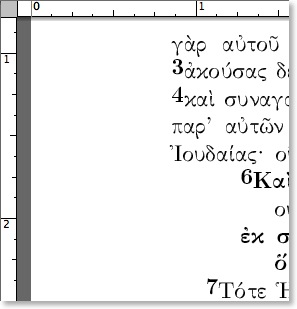
Again, this is an area where I with publishers would realize that those who buy products such as the RGNT appreciate not just thicker paper, but also wide margins for making notes, Regardless, whereas, the first edition's anemic margins were useless for any annotations, the new wider margins begin to approach a minimum width for note-taking,
Mlnl-Lexlcon. For those occasions when the reader forgels one of those words that occur more than 30 times, a new mini-lexicon has been added, presumably in the back of the RGNT.
Maps. Four new color maps have been added to the second edition of the RGNT. Already UBS/NA Greek New Testaments tend to have basic contextual maps inside the front and back covers. With the addition of these maps to the RGNT, this resource begins to take the feel of a standard reference tool and even a one-stop instrument for public use.
And the rest. Like the first edition, the new RGNT comes in an Italian Duo-Tone binding, I've stated before that I like this material just as much as actual leather. Assuming that these covers are going to hold up over decades-long use, I find them to be a very adequate substitute for real leather, especially if this keeps the price down. Perhaps Zondervan could put a disclaimer on the copyright page: "No cows were harmed in the publishing of this New Testament."
And of of course, the RGNT second edition will continue to offer lexical forms of words that occur less than 30 times in the Greek NT as well as noting where the text diverges from the UBS/NA texts. I'm pleased that they continue to keep these notes on the same page as the NT text, in footnote fashion, rather than by some other means.
I'll have more to say about the RGNT2 after I get my hands on one in November, Butfrom what l can already determine, it is already looking to be a great improvement over what was already a very practical and useful resource.
Biblical Fonts on the iPhone: Greek--YES! Hebrew--NO!
As I said in my post yesterday reviewing Bible apps on the iPhone, I would like to eventually see original language biblical texts on the iPhone in addition to the English translations already available. So I decided to conduct a couple of tests on my own. If the iPhone won't display Hebrew, will it display Greek?
First, I wanted to confirm the lack of Hebrew character support, so I ran over to Iyov's blog where I remember he used some Hebrew fonts last Monday in regard to a post by yours truly. Below is an actual photograph of my iPhone screen on Iyov's post "Brief Notes (Rosh Chodesh Av, 5767)":
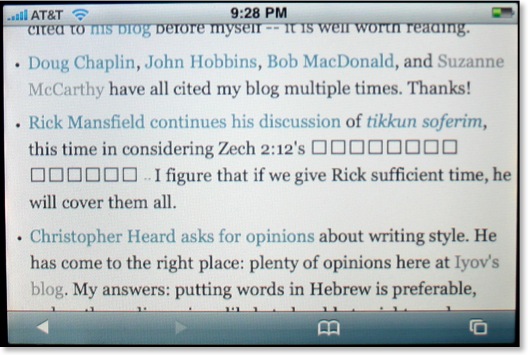
Sure enough--the Hebrew does not display at all.
So what about Greek? On Wednesday, Suzanne McCarthy posted an entry on the Better Bibles Blog titled "From Sapho 2." While not technically a biblical passage, the post includes Greek text. Here is another photo of my iPhone:
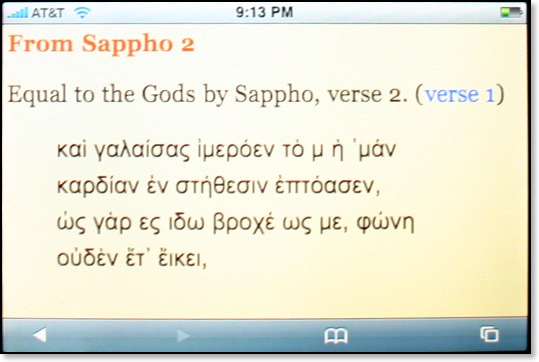
As you can see the Greek renders fine--in fact, it's perfect. So why doesn't the Hebrew? Modern Unicode fonts include characters for both Greek and Hebrew as well as quite a few other character language sets. My only conclusion is that iPhone v. 1 software uses limited font sets.
Hopefully, as the iPhone is introduced in other parts of the world, these missing languages--including Hebrew--will be added in.
A Journaling Greek New Testament?
In the comments from yesterday's post William Turner asked some very good questions relating to original language texts, especially the availability of wide-margin Greek and Hebrew texts. As I began answering him in the comments, I decided that others might be interested as well, and perhaps some of you could even help me answer his questions. I'll place William's questions and comments in bold and my answers will follow.
Do you know of anything like this for Greek or Hebrew? I know that UBS has A Reader's Greek New Testament but the paper is thin, the margins aren't really wide and there is vocab stuffed at the bottom. I guess what I am looking for it a Journaling GNT. I do have a really old (pre 20th century) two volume Hebrew Bible that has a blank page and then a text page, etc. So you always have one blank page to write notes. I am unaware of anything for Greek.
First, a word about A Reader's Greek New Testament: This Greek New Testament is actually from Zondervan, not United Bible Societies (UBS) and represents the Greek text underlying the New International Version (and perhaps the TNIV?). According to its introduction, it differs "from the standard text at 231 places" (p. 10). I have never taken the time to compare these differences from the Nestle-Aland (NA) text, but I can't imagine they would be of great significance. However, it is significant that we now have an alternative Greek text (besides something like Farstad's Majority Text NT) to the commonly used USB or NA texts (which are identical). Of course, if we think there is confusion now with so much choice in Bible translations, I wonder what it will be like if we begin to have a number of competing Greek texts? Over the years I've heard concerns as to what will happen to future editions of the standard Greek text once Bruce Metzger passes away and it is controlled by less conservative hands. Will we then start to see competing evangelical Greek New Testaments? It's an intriguing thought, but personally I hope not. It's regrettable that we can't agree on a standard translation anymore (yes, I find that regrettable, believe it or not), but I really don't want a multiplicity of original language texts, too.
Having said all that, I have a copy of A Reader's Greek New Testament and I carry it in my book bag to church on Sundays. Since it includes the vocabulary of all words that occur 30 times or less, it's quite handy for quick reference. I don't teach from it, but I use it to occasionally satisfy my own curiosity during the pastor's sermon or answer a question when I am teaching Sunday School. But, you're right, William; it does not really have enough space to take notes. And the text itself is in italics (like the UBS4), and in my opinion, that makes it harder to read. Nevertheless, it's good for what it does.
Now, to specifically answer your question... What I really recommend and like to use myself are the large print versions of the NA27 (ISBN 3438051036) and BHS (ISBN 3438052180). It seems that when the average person goes to buy an original language text for the first time, he or she is usually steered to one of the hand-size editions. In fact, these are the only editions most stores carry (if they carry such things at all).
The large print NA27 has about a half inch margin at the page's edge and a full inch at the bottom. There's even more room at the page's edge for texts that aren't over-burdened by cross-references. Plus there's just enough room between the lines of the Greek text that I can make tight notes above or below particular words. I've even known those who have taken one of these editions and written in the definitions of all words that occur ten times or less in the Greek text. There's enough room on the page that you could realistically do this.
The large print BHS (technically the standard size, actually) carries the same height and width dimensions as the large print NA27, but obviously much thicker. But because the are the same size, they nicely stand beside each other on a bookshelf. The BHS does not have margins as generous as the NA27, but there is still plenty of room to make notes between lines of text (if you can write small), and of course in poetic writings there's ample space. Although I might use pens and even dry highlighters in translations, I tend to only use a pencil for notes in my Greek and Hebrew texts. A sharpened lead or a mechanical pencil is perfect for fitting notes in tight places.
Incidentally, I have seen one professor who had both of these large print editions professionally bound together, like the hand-size Biblia Sacra, but it makes for too thick of a book in my opinion to recommend that.
Having said all that, there actually used to be a true wide-margin Nestle-Aland Greek New Testament. Basically, it was printed from the plates of the standard hand-size edition, but on the same-sized paper found in the large print. I'm almost positive this edition is no longer in print, and I've never seen anything more recent than the 26th edition of the NA in wide-margin anyway. While the margins weren't as wide as something like the ESV Journaling Bible, there was still plenty of room for lots of notations. Such things are the stuff of legends, but I've heard it told that decades ago when John Polhill was studying for his doctoral comprehensive final in Greek, he took a wide-margin Greek New Testament, and worked through all 27 NT books rendering his translation in the margins in just a few short months.
Perhaps someone reading this can provide an ISBN for the wide-margin NA26 or provide information about a newer edition if there is one in print. There are a variety of Greek texts available, but the descriptions at the ABS website are scant.
I made up a three column version with WORD for Rev. 1 in Greek, but it is a hassle to make. I am going to try it out in translating and see how it works. I have a smaller column on the left for notes on words then the middle column is the actual Greek text and then I have a third column for the actual translation.
When you translate do you have a specific method? That would be a good blog post by the way - I at least would be very interested in others translating habits.
I've often toyed around with the idea of making my own Greek New Testament and having it professionally bound. I have access to the entire Greek text in software and my laser printer features duplex printing capabilities, so while it would be time-consuming to set up, I certainly have the tools necessary. I'm certain that reproducing that much of the text would probably fall outside copyright limitations, but since it would be only for my own personal use, I could probably live with the guilt
William, I like your three-column layout and have used similar methods. I'll be honest that most of the time now when I translate for my own purposes, I simply use my Greek New Testament and a notebook. Nothing very fancy at all, but I do like to use a notebook because I want to keep what I've done. I know some guys swear by the need for diagramming--and I've done it before--but I'm too lazy to do it every time I translate (and frankly I don't feel I need to).
Now, when I was preparing translations for classes, I finally settled into a system similar to your three-column method. I would copy the text from a program like Accordance and then dump it into my word processor. I always liked to work with my page in landscape. I would create about an inch or more between every line of text and then leave about a three inch margin on the right. After printing it out, the space between my lines of text was enough room (using sharp lead or a mechanical pencil) to include parsing information and my own gloss. Then I would use the margin on the right to smooth out my final translation. Here's a link to an Adobe PDF file that shows Colossians 1-2 prepared in this format: Col 1-2
Sometimes I still make translation sheets like this when I'm doing serious work. My methods have never been too elaborate. I'd be interested in hearing from others as to their translation methods. I read somewhere that if you translate about 22 verses a day, you will translate the entire Greek NT in a year's time. I don't actually have time to translate that many verses everyday (I'm not yet fast enough!), but a while back I decided to try to do about ten verses a day. I figured this was a good way to stay fresh (since I'm no longer taking classes) and build my vocabulary at the same time. Granted, there are days I miss altogether, but it would be nice to translate completely through in say, three years.
What do some of you do? How do you keep your Greek (and/or Hebrew) fresh? Do you have translation goals? If so, what are they?
Also please post in the comments if you know of a particular wide-margin Greek or Hebrew text, or tell us if you have made your own text.










